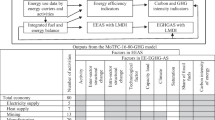Abstract
Energy demand and its related GHGs (mainly CO2) emission forecasting is critical for analyzing the energy situation to take essential steps before developing sustainable, reliable, and secure energy systems and addressing environmental protection obligations. This study focused on the projection of energy demand from 2017 to 2052 using a bottom-up model energy model MAED that includes detailed social, economic, and technological scenario analysis. The model is used to evaluate the business-as-usual and economic development scenarios. The results emphasize the exploration of renewable and other cheap, indigenous, and clean energy sources in Pakistan.
Access this chapter
Tax calculation will be finalised at checkout
Purchases are for personal use only
Similar content being viewed by others
References
Amber KP, Aslam MW, Ikram F, Kousar A, Ali HM, Akram N et al (2018) Heating and cooling degree-days maps of Pakistan. Energies 11:1–12. https://doi.org/10.3390/en11010094
Bank TW. World Bank Open Data (n.d.). https://data.worldbank.org/
Change IP on C. Emission Factor Database (n.d.). https://www.ipcc.ch/
Doll CN, Oliveira JA (2017) Urbanization and climate co-benefits: implementation of win-win interventions in cities. Taylor & Francis, Milton Park
Farzaneh H (2017a) Multiple benefits assessments of the clean energy development in Asian cities. Energy Procedia 136:8–13
Farzaneh H (2017b) Development of a bottom-up technology assessment model for assessing the low carbon energy scenarios in the urban system. Energy Procedia 107:321–326
Farzaneh H (2018) Devising a clean energy strategy for Asian cities. Springer, New York. ISBN: 978-981-13-0781-2
Farzaneh H (2019) Energy systems modeling: principles and applications. Springer, New York
Farzaneh H, Suwa A, Dolla CN, Oliveira JA (2014) Developing a tool to analyze climate co-benefits of the urban energy system. Procedia Environ Sci 20:97–105
Farzaneh H, McLellan B, Ishihara KN (2016a) Toward a CO2 zero emissions energy system in the Middle East region. Int J Green Energy 13(7):682–694
Farzaneh H, Doll CN, Puppim de Oliveira JA (2016b) An integrated supply-demand model for the optimization of energy flow in the urban system. J Clean Prod 114:269–285
Farzaneh H, De Oliveira JA, McLellan B, Ohgaki H (2019) Towards a low emission transport system: evaluating the public health and environmental benefits. Energies 12(19):3747
Finance Division G of P. Pakistan Economic Survey (2018)
GoP (2013). Framework for Implementation of Climate Change Policy (2014–2030) Government of Pakistan. Climate Change Division, Islamabad, Pakistan
GoP, Ministry of planning development and R. Pakistan Vision 2025 2014
IAEA (2006) Model for analysis of energy demand (MAED-2) user’s manual. IAEA, Vienna, p 196
International Energy Agency (2019) CO2 emissions from fuel combustion. Outlook:1–92. https://doi.org/10.1670/96-03N
Ministry of Climate Change. National Climate Change Policy 2012
Ministry of Energy (Petroleum Division) | Hydrocarbon Development Institute of Pakistan (2018) Pakistan Energy Year Book 2018: 156
Oliveira JA, Doll CN, Siri J, Dreyfus M, Farzaneh H, Capon A (2015) Urban governance and the systems approaches to health-environment co-benefits in cities. Cad Saude Publica 31(suppl 1):25–38
Pakistan Bureau of Statistics (2016) Pakistan Social and Living Standards Measurement survey
Pakistan Bureau of Statistics (2017) District wise population by sex and rural/urban Government of Pakistan. 6th Popul Census 13
Singh S (2006) The demand for road-based passenger mobility in India: 1950-2030 and relevance for developing and developed countries. Eur J Transp Infrastruct Res:6. https://doi.org/10.18757/ejtir.2006.6.3.3448
UNDESA (2019) World Population Prospects 2019. https://population.un.org/wpp/Download/Standard/Population/
Author information
Authors and Affiliations
Corresponding author
Editor information
Editors and Affiliations
Rights and permissions
Copyright information
© 2021 The Author(s), under exclusive license to Springer Nature Singapore Pte Ltd.
About this chapter
Cite this chapter
Abrar, S., Farzaneh, H. (2021). A Quantitative Model for Forecasting Energy Demand and CO2 Emissions in Pakistan: Toward a Sustainable Energy System. In: Farzaneh, H., Zusman, E., Chae, Y. (eds) Aligning Climate Change and Sustainable Development Policies in Asia. Springer, Singapore. https://doi.org/10.1007/978-981-16-0135-4_3
Download citation
DOI: https://doi.org/10.1007/978-981-16-0135-4_3
Published:
Publisher Name: Springer, Singapore
Print ISBN: 978-981-16-0134-7
Online ISBN: 978-981-16-0135-4
eBook Packages: Earth and Environmental ScienceEarth and Environmental Science (R0)




